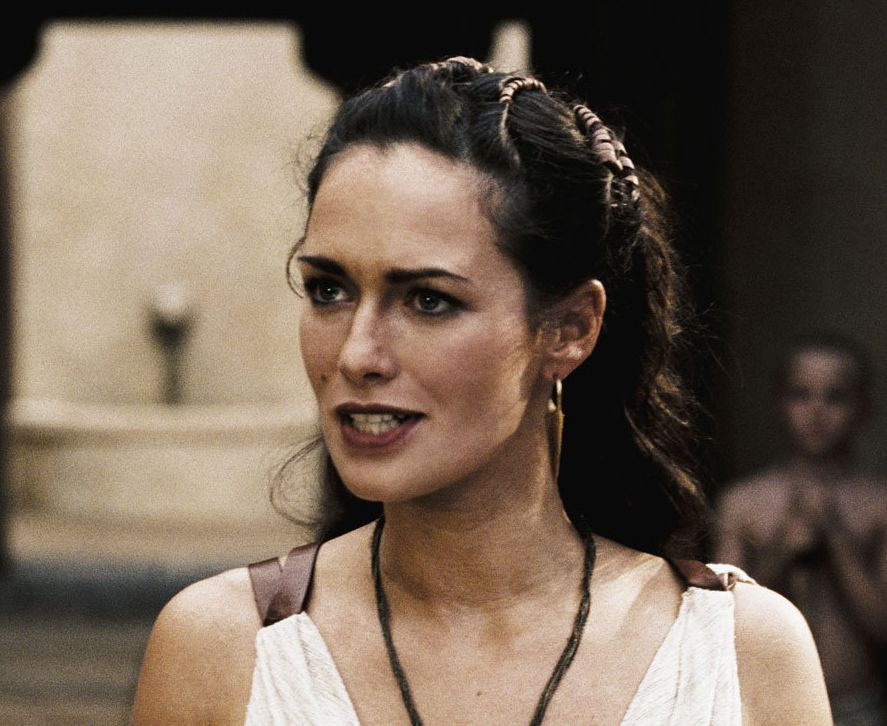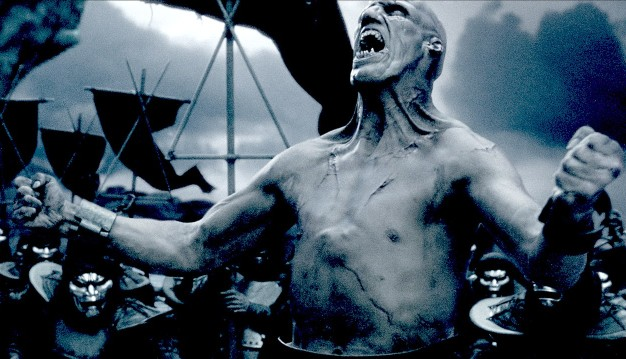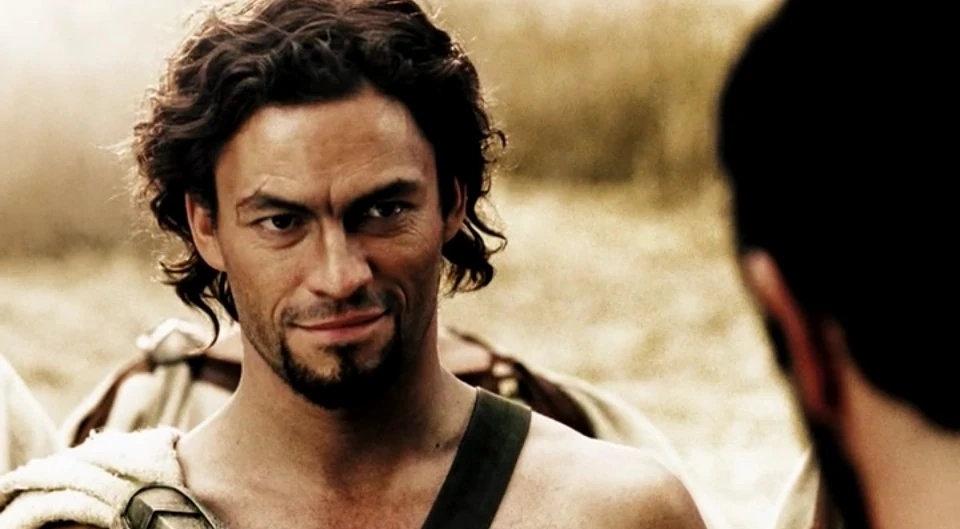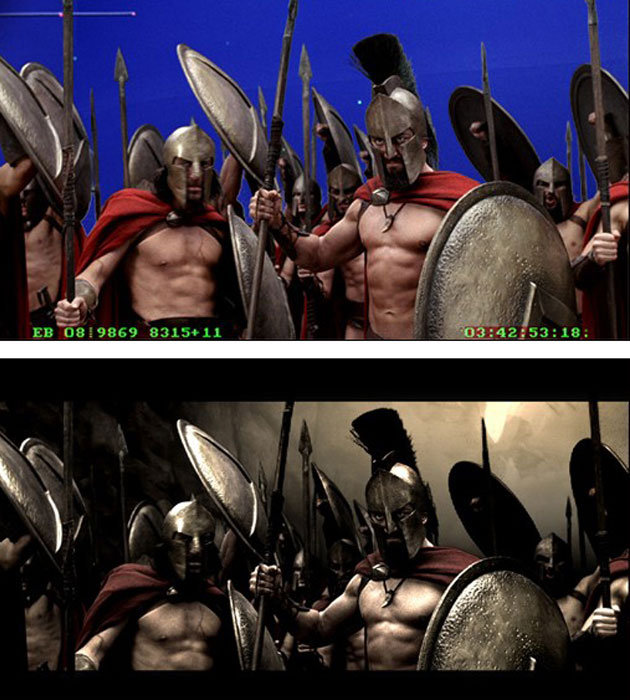Up until now, my retrospective on the historical epics, of the late 90s and early 2000s, including the likes of Gladiator and Troy, felt very dramatic and practical; tangible recreations of history with lavish sets, costumes and tons of extras. Controversial director Zack Snyder came around with his 2006 adaptation of Frank Miller’s seminal graphic novel 300. Instead of megasets and tons of extras, a lot of 300 would be created with the use of chroma key (blue screen) backgrounds, with some props and minor sets used at the same time. Alongside the Star Wars prequels, it could be one of the films that normalized this kind of filmmaking in Hollywood, especially in the years to come.
If you’re unfamiliar with history, 300 is a very loose retelling of a real historical event, the Battle of Thermopylae, which was fought over three days by an alliance of Greeks, led by King Leonidas I, and the Persian invaders, led by Xerxes I. The film is framed via narrative voice-over by Dilios, a Spartan soldier retelling the events of the battle to the Greek army. Using the power of embellishment, he exaggerates, creates and omits details in order to hype up his fellow Greeks on the eve of the Battle of Plataea. This is what allows the film to tip into the realm of fantasy and distortion, so we the audience are expected to suspend disbelief. It doesn’t always work, unfortunately, with the fantastical elements coming off as bizarrely out of place even for an embellished story, while the portrayal of the Persians was quite controversial; more on that in a bit. As such, one of the biggest changes to the source text actually comes from the title. Yes, there were 300 spartans present at the battle, but the film and comic make it seem like it was only these 300 (and a handful of Arcadians who are all but absent from the battles) against the endless Perian hordes. In reality, the Greek army was between 5000 and 7000 strong, per Herodotus (who should be noted, was also a famed exaggerator of history).

In terms of the story, 300 follows Gerald Butler’s Leonidas, King of Sparta, who is offered to pledge his loyalty to Persia by bending the knee and presenting a token of earth and water (historically accurate). Fearing that this would lead to a horrid lack of freedom for his people, he urges the council to war, but due to oracles and lunar cycles, he’s prohibited from sending the army at such a time. So he elects to go himself with a small contingent of “bodyguards” to meet the invading force head-on, with hopes of inspiring the divided Greek nation into combat. Snyder also wisely adds a lot of political drama to his adaptation, creating a whole new plot line for Queen Gorgo (Lena Hadley) as she deals with the scheming and dealing of the council in an attempt to secure the army’s formation in a surprisingly layered subplot that actually enhances the film, elevating it beyond just an action film by showing political corruption and scheming at home from the point of view of the Queen in a film that seems to relish the macho-manliness of the spartans.

300 takes a while to get to its first action sequence, but once it gets there, the film doesn’t pull back on the throttle, offering more of an action spectacle than a drama like its contemporaries of the time. This isn’t per se a bad thing either, 300 knew what it wanted to do and be and did it well for the most part. I wouldn’t say the action is that amazing though, apart from the opening sequence, it all kind of blurs together after a while. Some of the action is treated as a montage and some of the more interesting set pieces, such as facing elephants or rhinos, are relegated to being short bit pieces within said montages as opposed to a memorable set piece. The CG blood effects also look weird, appearing more like specs of dirt more often than not (I preferred the blood effects in the sequel despite how digital it looked) and the yellow filter does make the film appear a bit flat at times. Oh and it has to be mentioned; yes the music ranges from generic to awesome, but a lot of the most memorable tracks in the movie are actually heavily plagiarized versions of Elliot Goldenthal’s score from Titus, so much so that Warner Bros. actually had to put out a statement, saying:
A number of the music cues for the score of 300 were, without our knowledge or participation, derived from music composed by Academy Award-winning composer Elliot Goldenthal for the motion picture Titus. Warner Bros. Pictures has great respect for Elliot, our longtime collaborator, and is pleased to have amicably resolved this matter.
W.B.
The Iranian government was, naturally, livid about 300, resulting in first condemnation before outright banning it over the demonized portrayal of the Persians, which seeing as how Xeres’ forces were portrayed as deformed monsters (literally), one can understand why. Even with Dilios acting as an unreliable narrator, the end result is still pretty cringe, so much so that the sequel, 300: Rise of an Empire, seriously toned down the demonizing of the Persians, making them appear as *gasp*, human, as opposed to monstrous. The Iranians went so far as to say 300 was U.S. government propaganda, with the sole objective of hyping up the American people for a potential war with Iran.

Despite being more of an action spectacle, all the actors are really doing a solid job with the script. Gerald Butler is quite memorable as Leonidas, balancing yelling awesome quotes and more quiet reserved meditation. David Wenham’s narration as Dilios also draws the audience in like a good orator should and Lena Headley gives a lot more nuance and depth to a character who is barely in the original comic. Other members of the cast include Rodrigo Santoro as Xeres (who sounds like he’s in a witness protection video), The Wire’s Dominic West as a corrupt politician, and Michael Fassbender, who gets to deliver a paraphrased version of the historical line “we shall fight in the shade” (Herodutus, again).

Snyder and his team aimed to recreate Frank Miller’s beloved graphic novel 300 as faithfully as possible. With this in mind, 300 the film is a huge success. Many of the imagery and lines are ripped straight from the source material, making the movie feel like a moving comic at times. Being a graphic novel originally, the art style is hyper-stylized and Snyder adheres to that with his adaptation, putting style over substance to ensure that the original spirit is translated. The film does appear quite dated now in some spots, especially with regard to the CGI animals, and the backgrounds and props can feel a bit flat and simple by today’s standards. Overall though, this respect for the source material and the film’s emphasis on action and spectacle made 300 a smash hit. It was made on a budget of $60 million, (versus, say Kingdom of Heaven’s $130 million) and made almost half a billion. Naturally, everyone wanted to hop on this bandwagon.

While Gladiator had its share of imitators after its success, 300 had the same knock-on effect, this time using style and an emphasis on VFX to make the films more fantastical. Whether this be Clash of the Titans in 2010, the Spartacus TV series, Immortals, or Gods of Egypt, we entered an era where blue screen backdrops dominated this kind of genre, and the emphasis moved away from drama and more into action (I’ll say that Spartacus balanced both due to being a show that lasted three full seasons, but still used stylized violence and backdrops in direct inspiration of 300). Despite the use of digital effects, 300 was still shot on film and there’s quite a bit of film grain present in the final cut, which I like.
I would also cite 300 for the still-current Hollywood craze of having its male leads look like Greek statues, pushing themselves beyond their physical limitations to create highly unrealistic body compositions. The effect can be seen in nearly every superhero film these days.

I think 300 is better than people may remember it being, but it’s also not as great as it was hyped up to be. The visuals, while authentic to the source material, can come across as being cheap or basic and the movie can end up feeling samey and repetitive at times. Snyder’s emphasis on style over substance does detract from the film from time to time and his directional style, such as an overreliance on slo-mo, is frustrating at times. But we’re rooting for the characters as the film frames the Spartans as larger than life and as the defenders of freedom (despite their barbarism), so it’s naturally a framing device that works well with Western audiences. Snyder would co-write (but not direct) the 2014 sequel, 300: Rise of an Empire, which was far more of a mixed bag than the original. But, watching 300 as an adaptation of a comic, rather than a historical epic, it’s still pretty entertaining, but it’s also frustrating to see how cinema changed as a result of this film. But Ridley Scott seems determined to reinvigorate the genre as of late, with The Last Duel and Napoleon being his attempts at this. But it’s the upcoming Gladiator II that will really determine if the practically shot sword-and-sandal epic will make a true comeback. Time will tell.

For all of the deserved criticisms leveled at Snyder, the guy knows how to make a good-looking movie. Like WATCHMEN, 300 felt like a comic book come to life for me. I never once considered that it could be historically accurate. Most movies that claim to be usually aren’t.
LikeLike